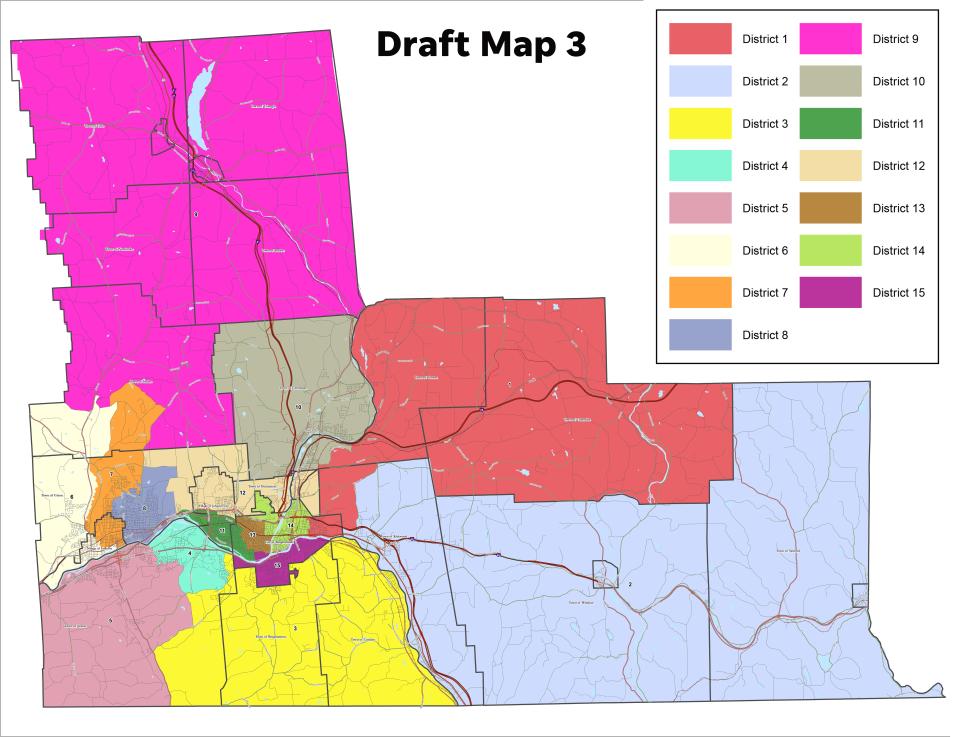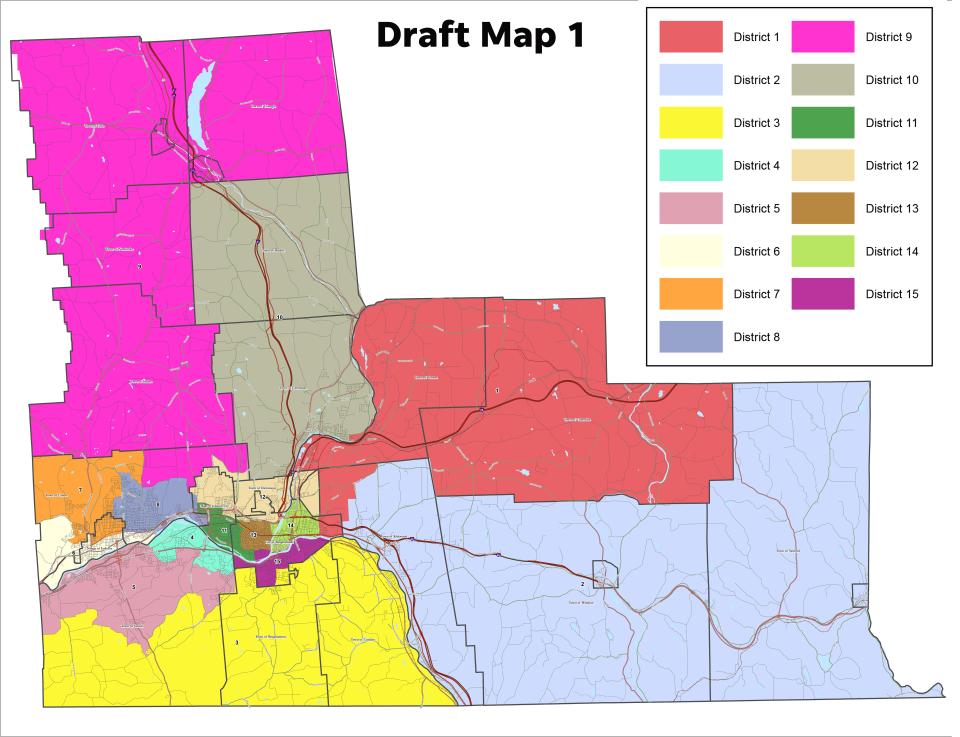Broome County approves new district map, but will it last? Democrats are skeptical
The Broome County legislature has a new district map, but the debate may be far from over.
Legislators approved Map 3 Tuesday night in a 9-6 vote along party lines, with Republicans in favor and Democrats opposed to the new legislative borders that will be in place for the next decade.
Several Democrats suggested the county could be open to a lawsuit challenging the legality of Map 3.
“I think the Ad Hoc Committee as well as the legislature has given the residents of Broome County no other choice than to take the county government to court and force them to adhere to state law,” said District 15 legislator Mark Whalen. “It’s something that I abhor but it is a viable option.”
The vote was initially scheduled for last Thursday, but Whalen requested the matter be held over until the next meeting of the legislature. That came Tuesday evening in another special session called by Chairman Daniel J. Reynolds. Democrats on Tuesday proposed tabling Map 3 and sending it back to the redistricting Ad Hoc Committee for revision, but were defeated 10-5.
Reynolds pushed back on the claim that Map 3 was the result of gerrymandering. The new map hews closely to the current borders, which were approved with a single dissenting vote a decade ago.
“Reasonable people can look at the exact same information and walk away with two uniquely different conclusions, but what I don’t see is evidence to support the conclusions that are being drawn regarding either gerrymandering or that these districts are somehow unfair. They just aren’t,” said Reynolds. “I’ve looked at these districts and know the statistics extremely well and I’m hard-pressed to find an area where I find these districts are not either representative or fair.
"Are they perfect? No. You’re asking for a standard, if that’s the case, that doesn’t exist in districting.”
Redistricting: Broome County's legislative districts will change in 2022. What to know about the plan
For subscribers: How ice cream shops open year-round handle Southern Tier winters
Local politics: New Endicott deputy mayor hopes to 'bridge the gap' between mayor, board of trustees
Population shift in Broome County impacted redistricting
The county undertakes the redistricting process once a decade following the results of the Census. The 2020 count forced some changes to the district map as Broome County lost about 1% of its overall population, with the decline mostly concentrated in rural areas. The county’s population centers, in contrast, saw modest gains since 2010.
That dichotomy helped fuel an urban vs. rural divide as new maps were drawn in the last few months.
“We gained population in the urban core. In the Tri-Cities area, we gained 1-2% in the City of Binghamton, Johnson City and the Village of Endicott, yet our districts have not changed at all to reflect that,” said Susan Ryan, a Democrat representing the 11th District. “If you look at the population of Broome County, over half of the people are housed in the Triple Cities and the Town of Union. This means over half of our representatives should be located there. It’s a fundamental part of our democracy.”


Critics assailed Map 3 for splitting the Town of Maine up into three different districts. Maine town supervisor Jim Tokos, a Democrat, objected to the decision during Thursday’s public hearing.
“We should be an entity on our own,” said Tokos. “We have nothing in common with Endicott. To be split into three ways, north Maine and then with two in Endicott makes no sense to me.”
Democrats proposed an alternative to Map 3, Map 1, that did not split the Town of Maine. Map 1 drew criticism from Republicans for breaking up communities of interest and diluting population centers in rural parts of Broome County. One particular point of contention was Map 1’s decision to move the Town of Barker to another district, breaking it away from Lisle, Whitney Point, Nanticoke and other parts of northern Broome County.
District 9 legislator Matt Hilderbrant noted three quarters of Barker is covered by the Whitney Point school district.
“Geographically and culturally speaking, the nature of the town of Barker mirrors the characteristics of northern Broome towns,” said Hilderbrant, who added that Map 1 lumped Barker with the Town of Chenango. “It just doesn’t make sense. These areas just don’t operate the same when you put them together.”
Reynolds noted that some portion of Barker has been in the northern district since the county’s inception, while Maine has been split several times over the decades. Given the population of northern Broome, it was impossible to place Barker and the entirety of Maine in the northern district. Reynolds said other maps were "an attack" on the rural areas of the Broome County community.
The redistricting process is regulated by state law. The maps had to be drawn with the 15 districts as close to equal in population “as practicable.” The difference between the most and least populous district could not exceed 5% of the average population of all districts. In Broome County, that figure is 13,246 — the target for total population in each new district.
Districts must be contiguous, and must be as compact as possible. State law prohibits districts from being drawn to discourage competition. Districts cannot favor or disfavor incumbents, other particular candidates or political parties. Redistricting is also designed to keep traditional voting blocs together.
Broome County Democrats emphasized minimal deviations in population during the redistricting debate, while Republicans focused on maintaining core districts and communities of interest, as well as existing political subdivisions.
Mary Kaminsky, a Democrat representing the14th District, said approving Map 3 is “inviting a lawsuit” that could prove costly for taxpayers.
“We have a map whose districts are not nearly equal in population as practicable,” said Kaminsky. “We have a map that divides the town of Maine despite two places in the law where it says you shouldn’t do that. We have a map that an expert from Binghamton University, who has published extensively on this subject, testified was a partisan gerrymander.
“All these clear violations of New York State law are supposedly OK because this map takes maintaining the cores of existing districts into consideration? It’s not even clear what maintaining cores means, but that single thing allows us to disregard multiple clear requirements of the law? I don’t think so.”
Republicans disagree. County attorney Robert G. Behnke advised the legislature that both Map 1 and Map 3 would stand up to legal scrutiny. Republicans highlighted the stability of Map 3, which keeps more than 90% of Broome County residents within their current district. Map 3 is expected to largely maintain current party registration numbers, with some small deviations. Reynolds noted county executive Jason Garnar, a Democrat, easily won some Republican legislative districts in 2020.
District 1 Republican Stephen Flagg said Map 3 adds a few hundred registered Democrats to his district.
“To me, that map is fair. It fits all the criteria, it’s backed by the county attorney, it takes into account communities of interest. Small communities are protected,” said Flagg. “I don’t think any other maps accomplish that. Map 3 encourages competition and doesn’t guarantee a majority for any party in Broome County because at the end of the day the ultimate decision on representation is up to the voters.”
What the community is saying
Eleven Broome County residents addressed the legislature during a public hearing Thursday, including a mix of elected officials and community members.
Margaret Goodfellow, co-president of the League of Women Voters of Broome and Tioga counties, said the redistricting process offered the chance to expand representation among Broome’s minority populations.
“Broome County has seen a declining population, particularly in rural areas due to deaths, job loss and outmigration. It has also experienced modest but steady growth of minority populations in the last decade, giving rise to the opportunity for long deserved representation in local government and elected office,” said Goodfellow.
Mary Johnson of the League of Women Voters was appointed to the redistricting Ad Hoc Committee as one of two public representatives. Johnson voted against Map 3.
“Map 3 is a distorted map and suggests possible partisan objectives seeking ensured dominance of a political party or perhaps even individual candidates,” Goodfellow said during the public hearing.
Each resident to address the legislature spoke in favor of Map 1, including Lori Schapiro, of Vestal.
“I do not feel any person in Broome County should have their vote diluted by the fact that certain districts are populated with more people or less. They should be as equal as practicable,” said Schapiro. “While Map 3 might be within the statutory criteria, Map 1 clearly allows the districts to be much more equal, which will allow every resident of Broome County’s voice to be heard equally. It won’t be weighted, it won’t be diluted. I think a fair map is what we deserve as constituents of this county.”
Chris Potter can be reached at cpotter@gannett.com or on Twitter @ChrisPotter413. To get unlimited access to the latest news, please subscribe or activate your digital account today.
This article originally appeared on Binghamton Press & Sun-Bulletin: Broome County legislative map approved after 2020 Census

